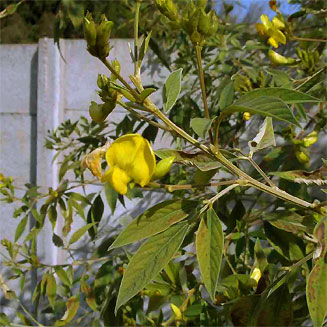|
Cajanus cajan (Pigeon pea, Red gram)
duifert [Afrikaans]; udali [Zulu];
dahl, dhal, dal, dholl [Hindu] Life
> eukaryotes >
Archaeoplastida >
Chloroplastida
>
Charophyta > Streptophytina > Plantae (land plants)
> Tracheophyta (vascular plants) > Euphyllophyta > Lignophyta (woody plants)
> Spermatophyta (seed plants) > Angiospermae (flowering
plants) > Eudicotyledons > Core Eudicots > Rosids >
Eurosid I > Fabales > Family: Fabaceae > Subfamily: Papilionoideae
 |
 |
|
Cajanus cajan, Reps Theatre carpark,
Zimbabwe. [photos Bart Wursten ©, Flora of Zimbabwe] |
Evidence suggests that Pigeon pea originated in India and
from there was introduced to East Africa around 4000 years ago. It is grown in semi-arid and subtropical areas of
the world, including Asia, Africa and South America. In Africa the main
countries growing Pigeon pea are Kenya, Malawi, Uganda, Tanzania and Nigeria,
but it is also grown in southern Africa in warm regions. It is grown mainly as a
subsistence crop. It has become naturalised in the
northerly parts of southern Africa.
Uses
- Seeds are soaked for several hours, pounded, fried or
steamed, and then eaten.
- Seeds are germinated and eaten as sprouts.
- Split peas are prepared by by softening and removing
the seed coat and then splitting the two cotyledons. The Hindu name dal
means 'to split'.
- Young pods are boiled and eaten as a vegetable.
- Dry stalks are used for thatching or fuel.
Links
Publications
-
Shanower, T.G., Romeis, J. & Minja, E.M.
1999. Insect pests of Pigeonpea and their management. Annual Review of
Entomology 44: 77-96.
-
van Wyk, B.-E. & Gericke, N. 2000. People's
Plants. A Guide to Useful Plants of Southern Africa. Briza Publications,
Pretoria.
|
